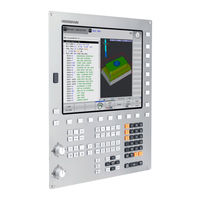HEIDENHAIN TNC 320 Manuals
Manuals and User Guides for HEIDENHAIN TNC 320. We have 3 HEIDENHAIN TNC 320 manuals available for free PDF download: User Manual, Operating Instructions Manual
HEIDENHAIN TNC 320 User Manual (581 pages)
CNC control Conversational Programming
Brand: HEIDENHAIN
|
Category: Control Systems
|
Size: 15 MB
Table of Contents
Advertisement
HEIDENHAIN TNC 320 User Manual (724 pages)
ISO programming
Brand: HEIDENHAIN
|
Category: Control Systems
|
Size: 15 MB
HEIDENHAIN TNC 320 Operating Instructions Manual (64 pages)
Programming Station
Brand: HEIDENHAIN
|
Category: Controller
|
Size: 3 MB
Table of Contents
Advertisement


